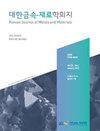Spheroidization Heat Treatment Conditions with Data Analysis in Medium Carbon Cr-Mo Steel for Ultra High Strength Cold Heading
IF 1.1
4区 材料科学
Q4 MATERIALS SCIENCE, MULTIDISCIPLINARY
引用次数: 0
Abstract
The degree to which parameters affect the spheroidization heat treatment of steel was calculated by setting the spheroidization heat treatment conditions of Cr-Mo steel and using data analysis such as S/N ratio and ANOVA. After analyzing the transformation temperatures of the steel, Ac1 and Ac3 , using a DSC, the conditions were set accordingly. The surface hardness was measured for the conditions and used as an evaluation index. The correlation was analyzed by comparing the spheroidized volume fraction and the surface hardness, and the Pearson correlation coefficient was -0.88, proving that a correlation existed between the two values. Using S/N ratio and ANOVA, the degree to which each control parameter affects the decrease in the surface hardness was analyzed, qualitatively and quantitatively. For the S/N ratio, priority affecting the surface hardness for each control parameter was analyzed. The 1st heating temperature was found to have a more preferential effect on the surface hardness than the 1st heating time and the 2nd heating temperature. Using ANOVA, the 1st heating temperature was determined to be a very significant factor with the greatest influence, contributing 73.2% to the surface hardness. Intercritical annealing is a suitable spheroidization heat treatment condition, so if the surface hardness of the steel needs to be reduced using Intercritical annealing, the 1st heating temperature and time should be designed as the priority.超高强度冷镦中碳Cr-Mo钢球化热处理条件及数据分析
通过设定Cr-Mo钢的球化热处理条件,并使用S/N比和ANOVA等数据分析,计算了参数对钢的球形化热处理的影响程度。在使用DSC分析钢Ac1和Ac3的转变温度之后,相应地设定条件。在该条件下测量表面硬度,并将其用作评价指标。通过比较球化体积分数和表面硬度来分析相关性,Pearson相关系数为-0.88,证明这两个值之间存在相关性。使用S/N比和方差分析,定性和定量分析了每个控制参数对表面硬度降低的影响程度。对于S/N比,分析了每个控制参数对表面硬度的优先影响。发现第一加热温度对表面硬度的影响比第一加热时间和第二加热温度更优先。使用方差分析,第一次加热温度被确定为影响最大的非常显著的因素,对表面硬度的贡献率为73.2%。亚临界退火是一种合适的球化热处理条件,因此,如果需要使用亚临界退火来降低钢的表面硬度,则应优先设计第一次加热温度和时间。
本文章由计算机程序翻译,如有差异,请以英文原文为准。
求助全文
约1分钟内获得全文
求助全文
来源期刊

Korean Journal of Metals and Materials
MATERIALS SCIENCE, MULTIDISCIPLINARY-METALLURGY & METALLURGICAL ENGINEERING
CiteScore
1.80
自引率
58.30%
发文量
100
审稿时长
4-8 weeks
期刊介绍:
The Korean Journal of Metals and Materials is a representative Korean-language journal of the Korean Institute of Metals and Materials (KIM); it publishes domestic and foreign academic papers related to metals and materials, in abroad range of fields from metals and materials to nano-materials, biomaterials, functional materials, energy materials, and new materials, and its official ISO designation is Korean J. Met. Mater.
 求助内容:
求助内容: 应助结果提醒方式:
应助结果提醒方式:


